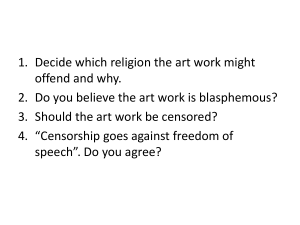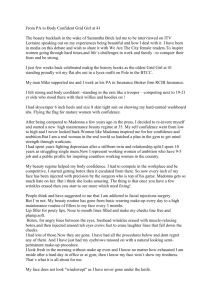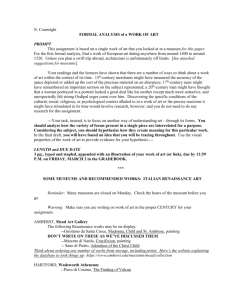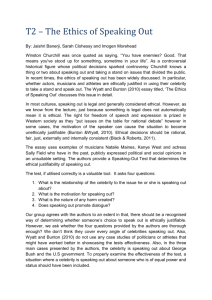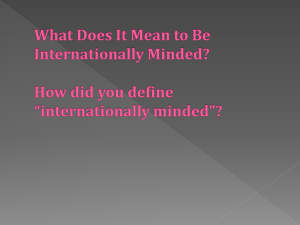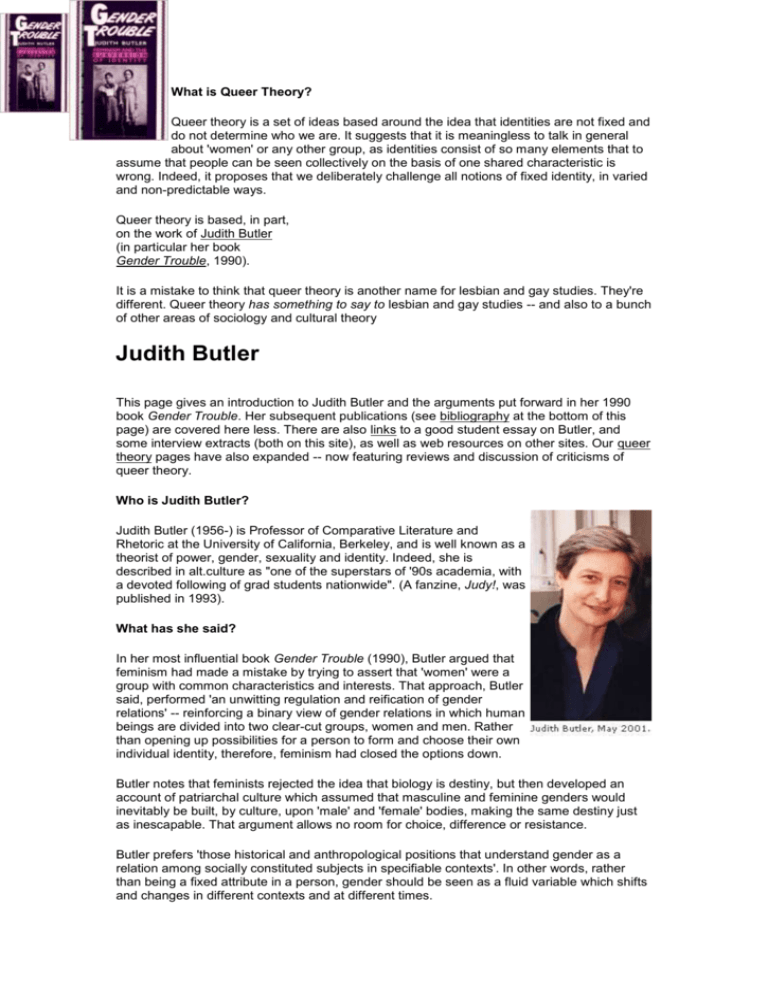
What is Queer Theory?
Queer theory is a set of ideas based around the idea that identities are not fixed and
do not determine who we are. It suggests that it is meaningless to talk in general
about 'women' or any other group, as identities consist of so many elements that to
assume that people can be seen collectively on the basis of one shared characteristic is
wrong. Indeed, it proposes that we deliberately challenge all notions of fixed identity, in varied
and non-predictable ways.
Queer theory is based, in part,
on the work of Judith Butler
(in particular her book
Gender Trouble, 1990).
It is a mistake to think that queer theory is another name for lesbian and gay studies. They're
different. Queer theory has something to say to lesbian and gay studies -- and also to a bunch
of other areas of sociology and cultural theory
Judith Butler
This page gives an introduction to Judith Butler and the arguments put forward in her 1990
book Gender Trouble. Her subsequent publications (see bibliography at the bottom of this
page) are covered here less. There are also links to a good student essay on Butler, and
some interview extracts (both on this site), as well as web resources on other sites. Our queer
theory pages have also expanded -- now featuring reviews and discussion of criticisms of
queer theory.
Who is Judith Butler?
Judith Butler (1956-) is Professor of Comparative Literature and
Rhetoric at the University of California, Berkeley, and is well known as a
theorist of power, gender, sexuality and identity. Indeed, she is
described in alt.culture as "one of the superstars of '90s academia, with
a devoted following of grad students nationwide". (A fanzine, Judy!, was
published in 1993).
What has she said?
In her most influential book Gender Trouble (1990), Butler argued that
feminism had made a mistake by trying to assert that 'women' were a
group with common characteristics and interests. That approach, Butler
said, performed 'an unwitting regulation and reification of gender
relations' -- reinforcing a binary view of gender relations in which human
beings are divided into two clear-cut groups, women and men. Rather
than opening up possibilities for a person to form and choose their own
individual identity, therefore, feminism had closed the options down.
Butler notes that feminists rejected the idea that biology is destiny, but then developed an
account of patriarchal culture which assumed that masculine and feminine genders would
inevitably be built, by culture, upon 'male' and 'female' bodies, making the same destiny just
as inescapable. That argument allows no room for choice, difference or resistance.
Butler prefers 'those historical and anthropological positions that understand gender as a
relation among socially constituted subjects in specifiable contexts'. In other words, rather
than being a fixed attribute in a person, gender should be seen as a fluid variable which shifts
and changes in different contexts and at different times.
The very fact that women and men can say that they feel more or
less 'like a woman' or 'like a man' shows, Butler points out, that 'the
experience of a gendered... cultural identity is considered an
achievement.'
Butler argues that sex (male, female) is seen to cause gender
(masculine, feminine) which is seen to cause desire (towards the other
gender). This is seen as a kind of continuum. Butler's approach -inspired in part by Foucault -- is basically to smash the supposed links
between these, so that gender and desire are flexible, free-floating and
not 'caused' by other stable factors.
Butler says: 'There is no gender identity behind the expressions of
gender; ... identity is performatively constituted by the very
"expressions" that are said to be its results.' (Gender Trouble, p. 25). In other words, gender
is a performance; it's what you do at particular times, rather than a universal who you are.
Butler suggests that certain cultural configurations of gender have seized a hegemonic hold
(i.e. they have come to seem natural in our culture as it presently is) -- but, she suggests, it
doesn't have to be that way. Rather than proposing some utopian vision, with no idea of how
we might get to such a state, Butler calls for subversive action in the present: 'gender trouble'
-- the mobilization, subversive confusion, and proliferation of genders -- and therefore identity.
Butler argues that we all put on a gender performance, whether traditional or not, anyway,
and so it is not a question of whether to do a gender performance, but what form that
performance will take. By choosing to be different about it, we might work to change gender
norms and the binary understanding of masculinity and femininity.
This idea of identity as free-floating, as not connected to an 'essence', but instead a
performance, is one of the key ideas in queer theory. Seen in this way, our identities,
gendered and otherwise, do not express some authentic inner "core" self but are the dramatic
effect (rather than the cause) of our performances.
David Halperin has said, 'Queer is by definition whatever is at odds with the normal, the
legitimate, the dominant. There is nothing in particular to which it necessarily refers. It is an
identity without an essence.'
It's not (necessarily) just a view on sexuality, or gender. It also suggests that the confines of
any identity can potentially be reinvented by its owner...
And finally -- what has this got to do with media and communications studies? Well, the
call for gender trouble has obvious media implications, since the mass media is the primary
means for alternative images to be disseminated. The media is therefore the site upon which
this 'semiotic war' (a war of symbols, of how things are represented) would take place.
Madonna is one media icon who can be seen to have brought queer theory to the masses.
Madonna and Gender Trouble
By Reena Mistry
With her constant image changes, parodies of blonde bombshells such as Marilyn Monroe,
her assertion of female power and sexuality, and her appropriation from gay/queer culture,
the popular music icon Madonna can be seen as the virtual embodiment of Judith Butler's
arguments in Gender Trouble (1990, 1999). In this postmodern feminist text, which is credited
with introducing 'queer theory' to the world, Butler critiques identity-based politics as the
method for female emancipation, claiming that presenting 'women' as a coherent group
performs 'an unwitting regulation and reification of [binary] gender relations' (1999:9). She
exposes and derationalizes the social power systems that construct the norms regarding the
'natural' gender identities of men and women, the 'logic' of heterosexuality, and the idea of a
pre-discursive core gender identity, through which women are subordinated, and
homosexuals, cross-dressers, and those others who are located beyond the 'imaginable
domain of gender', are marginalised (ibid:13). Butler suggests that 'subversive' identities
demonstrating the constructedness of sex-gender-desire continuity will work to destroy its
normative status, thus allowing all 'cultural configurations of sex and gender [to] proliferate'
and become intelligible (i.e. not deviant) (ibid:190). In that Madonna parodies traditional
female stereotypes and adopts at her will identities that 'contradict' herself as a heterosexual
female, Butler's idea of the ability for a 'variable construction of identity' (ibid:9) beyond
traditional binary constructions is exposed. Further therefore, people are not restricted to (in
addition to 'traditional' gender identities) the empowered female, gay and lesbian; in true
queer theory style, 'one could participate in a range of identities - such as the lesbian
heterosexual, a heterosexual lesbian, a male lesbian, a female gay man, or even a feminist
sex-radical' (Schwichtenberg 1993:141). Indeed, Madonna has demonstrated such fluidity
and ambiguity through her sexual political work - notably in the music videos for Vogue,
Erotica and Justify My Love, her film Truth or Dare: In Bed With
Madonna, and her book Sex.
The strong connection between Madonna and Gender Trouble is not one
that has gone unnoticed; a number of writers on popular culture, queer
politics and feminism have given it much consideration (see for example
Kaplan 1993, Schwichtenberg 1993 and Skeggs 1993). Within such
discussions - and others in 'Madonna Studies' - however, there is
evidence suggestive of a limit on the extent to which Madonna can be
seen to epitomise Butler's arguments. Moreover, she can be seen to
contradict the aim of subversive politics, despite her public support of gay rights, her AIDS
charity work and her 'flirtations' with lesbianism (Robertson 1996:119). Hence critics have
started to ask: "Is Madonna a glamorized fuckdoll or the queen of parodic critique?" (ibid:118).
The ways in which Madonna can be seen to contradict the political recommendations of
Gender Trouble are complex and stem from a number of critical perspectives - hence a
detailed understanding of Butler's work as the next step is essential. (In part, however, the
detailed description of Butler's arguments that follows is necessary also to demonstrate the
extent to which Madonna embodies these arguments, which led the two to be connected in
the first place. Thus, one of the aims of this essay is to determine how much Madonna
contradicts Gender Trouble in relation to the extent to which she embodies it. Perhaps this will
enable us to decide whether we can hold up Madonna as a political icon, a queer
ambassador as it were, or whether she should be resigned to a passing (flawed) example of
the variable construction of identity).
Butler opens Gender Trouble with a description of the established gender ontology in which
the duality of sex (i.e. male-female) forms the basis of gender identity (masculine-feminine).
This ontology carries with it the 'invocation of a nonhistorical "before"' (1999:5), hence the
idea that the duality of sex, and the gendered characteristics that are said to mirror sex, are
contrived is not entertained. Butler continues that the unity of sex and gender in the binary
system is maintained by its oppositional nature. Society sets up 'the experience of a gendered
psychic disposition or cultural identity [as] an achievement'. Hence 'one is one's gender to the
extent that one is not the other gender' (ibid:29-30). Following this, the unity of sex and
gender (the male's masculinity and the female's femininity) are seen to necessitate
heterosexual desire - male and female desire 'therefore differentiates itself through an
oppositional relation to that other gender it desires' (ibid:30). A causal relationship is
established, therefore, between sex, gender and desire. As a result, anything that falls outside
these gender configurations is seen as pathological, hence the marginalization of the
'assertive female,' the 'effeminate man,' the 'lipstick lesbian,' and the 'macho gay' (Sawicki
1994:301). As assertiveness, [ef]feminacy, lipstick and machismo are all allocated as various
heterosexual constructs which are therefore seen to be appropriated in homosexual/queer
contexts, the assertive female et al are seen merely as 'chimerical representations of
originally heterosexual identities' (Butler 1999:41). Thus the original gender ontology is reified
and rationalized.
Butler proposes that if the gender sequences of man and woman are fictive constructs - that
is, 'socially instituted and maintained norms of intelligibility' - 'gender as a substance, the
viability of man and woman as nouns, is called into question by the dissonant play of
attributes that fail to conform to sequential or causal models of intelligibility' (ibid:23, 32). The
idea that gender is not a noun leads Butler to one of her most notable arguments - that
gender is performative. 'Gender is always a doing, though not a doing by a subject who might
be said to preexist the deed… There is no gender identity behind the expressions of gender;
that identity is performatively constituted by the very "expressions" that are said to be its
results' (ibid:33). (Butler here draws on Nietzsche's claim that 'there is no "being" behind
doing, effecting, becoming; "the doer" is merely a fiction added to the deed - the deed is
everything').
With these arguments, Butler opens up two central sites for the 'intervention, exposure, and
displacement of [binary masculine/feminine] reifications' (ibid:42). First, the idea of using
heterosexual constructs in non-heterosexual frames, Butler notes, 'brings into relief the utterly
constructed status of the so-called heterosexual original' (ibid:41). Thus the repeated
performance of 'queer' identities may eventually be 'normalised' and seen as 'culturally
intelligible'. Second, Butler points to the potential of gender parody as exemplified by the
practices of drag, cross-dressing and butch/femme identities. The performance of drag
emphasises the discontinuity between anatomy (of the performer) and gender (that is being
performed); it also exposes the illusion of gender identity as a fixed inner substance (ibid:175,
187). 'In imitating gender, drag implicitly reveals the imitative structure of gender itself - as
well as its contingency' (ibid:175). Further, this notion of gender parody does not assume it
imitates an original, rather the parody is of the very notion of the natural and the original: 'gay
is to straight not as copy is to original, but, rather, as copy is to copy' (ibid:175, 41). Thus
there is 'subversive laughter' 'in the realization that all along the original was derived'
(ibid:186, 176). The displacement in drag suggests a 'fluidity of identities' that is open to
resignification and recontextualisation (ibid:176). Related to this is the postmodern notion of
pastiche; Jameson asserts that it is 'without [parody's] satirical impulse, without laughter,
without that still latent feeling that there exists something normal compared to which what is
being imitated is rather comic' (1983:114). Butler is adamant that this does not undermine the
subversive potential of gender parody, but is another site from which notions of core/fixed
gender identities can be exposed as fictitious.
It is from these sites of variable and fluid identity construction, parody
and pastiche that Madonna can be seen to embody Butler's call to cause
gender trouble, at which we will now look in detail. A central element of
Madonna's sexual politics is female empowerment and the freedom to
express female sexuality. She communicates this by taking on a 'butch'
role in the sense that she reappropriates the mechanisms used to control
women (Skeggs 1993:67). Most notable is her anti-antiporn position; she
uses the currency of pornography to challenge the idea of women as
passive sex objects. For example in the Open Your Heart video, the woman is seen to
perform pornographic acts for the men who pay to peep through a small screen. Skeggs
notes how 'as their money runs out and the screen slowly closes they are shown contorting to
try and see through the last minute slit. They look pathetic, silly and desperate' (ibid:68).
Similarly, in The Blonde Ambition Tour, Madonna performed sexual acts on her male dancers,
taking the 'top' position which, in the traditional sense, is a male reserve. (ibid:68).
Madonna also rejects the self-monitoring of female sexuality by disrupting the 'male gaze'
whereby 'Men act and women appear. Men look at women. Women watch themselves being
looked at' (Mulvey 1975; Berger 1972:47). Instead Madonna subjects men to the scrutiny of
her gaze, confronting the camera eye directly; 'looking at men is treated as something to be
blatant and positive about' instead of the usual case where 'women often avert their eyes in
modesty and submission to the gaze of the male audience' (Skeggs 1993:69; van Zoonen
1994:101). (Whereas traditionally dancing has been used to display the female body to men,
Madonna uses it to signify fun and self-indulgence. Hence the lyrics of Into the Groove: 'Only
when I'm dancin' do I feel this free'. 'Free' implies freedom from the male gaze; further dance
signifies power, energy and vitality, rather than passivity (Bradby 1994:85; Skeggs 1993:67)).
Hence Madonna claims "I can be a sex symbol, but I don't have to be a victim" (Robertson
1996:127).
Madonna is also seen to appropriate 'masculine' power through her notoriety for having
complete control over her career and image in a way that other female artists do not (Skeggs
1993:64; Robertson 1996:127). She also has a great deal of financial power - estimated at
around $200 million (Williams 1999:127) - thus she is perceived to be a shrewd
businesswoman.
The overt display of sexuality and the desire for control in women are typically labelled as
'whorish' and 'manipulative' by patriarchal narratives; Madonna throws such views back at
men by also emphasising what is 'female' in her. As Camille Paglia notes: 'Madonna is the
true feminist… Madonna has taught young women to be fully female and sexual while still
exercising control over their lives' (1990:39). Skeggs notes how she takes feminist issues of
domestic violence and emotional attachment seriously, 'express[ing] vulnerabilities and
celebrat[ing] strengths' (1993:65). Further, Madonna is not afraid to discuss her domestic side
and her role as a mother - it is not seen as an undermining of her capability for control. (In
Vanity Fair, she has recounted her domestic pleasure in picking lint from lint screens and
mating Sean [Penn]'s socks. More recently, she has become famous for her role as a mother
- and a good one at that. When asked: "What's been the most surprising thing about
motherhood?", she replied, "How much I could love something" (Hirschberg 1991:196-8;
William 1999:46)).
Madonna's appropriation of both 'male' and 'female' constructs supports Butler's idea of a
variable construction of identity. She takes this to the extreme by dressing in drag; in the
Express Yourself video, she wears a suit and monocle. At one point she teasingly opens and
closes the jacket to reveal a black lace bra, thus exposing gender as a 'put-on'
(Schwichtenberg 1993:135). Here, Madonna can be seen to mock male power and identity by
reducing gender and sex to the level of fashion and style (ibid:134).
More subversively, however, Madonna's parodic drag performances are
not limited to the appropriation of male style. Parker Tyler observes that:
'[Greta] Garbo "got in drag" whenever she took some heavy glamour
part, whenever she melted in or out of a man's arms, whenever she
simply let that heavenly-flexed neck… bear the weight of her thrown
back head… How resplendent seems the art of acting! It is all
impersonation, whether the sex underneath is true or not' (cited in Butler
1999:163). Madonna exposes femininity as a masquerade in her retrocinephiliac parodies of femme fatales such as Marilyn Monroe and Veronica Lake. In the
video for Material Girl, she imitates Monroe's "Diamonds are a Girl's Best Friend" number
from Gentlemen Prefer Blondes. The video reproduces the elements of blondness, sexuality
and gold-digging, but 'parodies the gold-digger's self-commodification as a form of 1980s
crass materialism: "The boy with the cold hard cash is always Mr. Right/ Cause we are living
in a material world, and I am a material girl"' (Robertson 1996:126). Madonna portrays a
'more savvy' Monroe in contrast to the traditional nostalgic treatment of her as a 'witless sex
object' (ibid:126). By manipulating the femme fatale image, Madonna demonstrates its
constructedness and performativity; further, simply by imitiating Monroe as one of a
succession of images in her career, Madonna mocks femininity as a 'meta-masquerade'.
Madonna's notorious image changes demonstrate what Butler referred to as the 'fluidity of
identity'. As part of these periodic style changes, Madonna dramatizes the discontinuity of
sex, gender and desire, particularly in Justify My Love, Truth or Dare and Sex. The Justify
video depicts Madonna in a sexual encounter with Tony Ward (a former gay porn model).
Later, other figures enter the scene, many are androgynous; one of them engages in an open
kiss with Madonna - it is difficult to tell whether it is male or female. Next we see two men
facing each other, and so Justify continues, 'alternately steamy and campy' (Henderson
1993:111). The polymorphism and ambiguity of these images blurs the boundaries
between sex, gender and desire, demonstrating that they are neither causal nor constant,
even within individuals.
A form of postmodern pastiche is recognizable in Justify My Love in that
Madonna borrows from gay subcultures - the record sleeve combines
gay male S&M imagery, Monroe features and a James Dean stance
(Skeggs 1993:71). In Vogue, she adopts the gay practice of vogueing,
which is prominent among African American and Latino gays, claiming "it
doesn't matter if you're black or white, if you're a boy or a girl", and that
anyone can "strike a pose, there's nothing to it". Combined with crossdressing images and retro-cinephilia, a camp-drag montage is created (Robertson 1996:1312). In this way, Madonna dissolves boundaries between gay subculture and mainstream
culture - thus you do not have to be gay to vogue, nor do you have to be straight to be a
femme fatale.
Indeed, it is Madonna's mainstream position in popular culture that facilitates her potential to
cause gender trouble (in a 1994 interview, Butler agreed that symbolic subversive politics is
tied to political practice through the role of the mass media (Osborne & Segal 1994)). Gay
journalist Don Baird writes that: 'Never has a pop star forced so many of the most basic and
necessary elements of gayness right into the face of this increasingly uptight nation with
power and finesse. Her message is clear - Get Over It - and she's the most popular woman in
the world who's talking up our good everything' (1991:33). Similarly, Carol Queen claims that
'The importance of Sex lies in its appearance in chain bookstores, its superstar creatrix, its
presence on the front page' (1993:151). Madonna seems to be a willing 'queer' supporter: she
has publicly aligned herself with gay politics being one of the first celebrities to perform in
AIDS benefits; biographies refer constantly to her close friendship with her gay dance teacher
Christopher Flynn; and she has jokingly refused to clarify he nature of her 'friendship' with
Sandra Bernhard (Robertson 1996:130-1).
It appears that Madonna's work mirrors Butler's vision of gender trouble very closely; the
examples outlined above provide a mere few of those that are available. Although the
evidence presents Madonna as a 'true feminist' and queer icon, a closer, more critical
analysis of her work reveals not only a number of factors undermining its subversive potential,
but also evidence that Madonna appropriates from sexual subcultures for her own ends rather
than for the ends of those from which she borrows. Moreover, there is reason to believe much
of her work is not subversive at all.
A central obstacle to the subversive potential of Madonna's work is that its audience may not
read it in the way they are intended to. Brown & Schulze found much variation in the way
students interpreted the videos to Papa Don't Preach and Open Your Heart; for example, the
pornography in Open (see above) led Madonna to be perceived by some as 'a classic object
of male desire' rather than demonstrating 'an escape from a patriarchal construction of
woman as "something to be looked at"' (1990:100, 97). Robertson notes how 'jewellery
thieves in… Resevoir Dogs argue if Like A Virgin is about "big dick" or female desire'
(1996:118). This signals either an unwillingness or inability of society to embrace the idea of
female sexuality; this is not restricted to men either - even Madonna's young female fans
describe her as 'tarty' (Bradby 1994:79). It seems patriarchal discourses embedded in society
reduce Madonna's sexual expression to prostitution - that is, a threat to society. Another
danger is that her parodic presentations of femme fatales are not read ironically; if this is the
case, all that is left is the makeup, high-heels and long hair, reinforcing the idea that women's
only purpose in life is to serve men. Thus despite her good intentions, Kaplan says we need
to decide 'if Madonna subverts the patriarchal feminine by unmasking it or whether she
ultimately reinscribes [it] by allowing her body to be recuperated for voyerism' (1993:156).
Clearly, overlooking the intended meaning of Madonna's work is an
obstacle; more fundamentally problematical, however, is the
contention that Justify My Love et al are not subversive at all. An
article in the New Yorker (February 1993) claims that: 'Camp is dead…gender tripping can't
be subversive anymore' because Madonna 'has opened all the closets, turning deviance into
a theme park' (in Robertson 1996:118). The 'heterosexualisation' of camp by popular culture
has led to a 'watering down' of its 'critical and political edge' (ibid:122). To make camp
culturally intelligible it has had to be mainstreamed - but Butler's notion that there is no
original implies that there should be no 'mainstream', every sex-gender-desire configuration
needs to be regarded on equal terms. This is not really something we can blame Madonna
for, but we do need to be aware of the restriction it places on her ability to subvert. Madonna's
heterosexualisation of camp suggests that her work may not be as 'queer' as it seems. For
example, one image in Sex 'seems to be designed to mark [Madonna] off from… the
[lesbians] in that scene… it's more like lesbians having sex together with Madonna along for
the ride' (Crimp & Warner 1993:109). Hence, 'she can be as queer as she wants to be, but
only because we know she's not' (ibid:95).
This 'superficial' queerness relates to accusations that Madonna uses her sexuality, changing
image and 'controversial' sex politics as mere fuel for publicity. Hooks claims that she 'publicly
name[s her]… appropriation of black culture as yet another sign of [her] radical chic'
(1992:157). Similarly with queer appropriation, 'the gay men in [Sex] seem to be there more
as suppliers of sexual glamour than actual sexual partners… It's more about their exotic
appeal… than it is about gay sex' (Crimp & Warner 1993:97). Similarly, rather than a variable
construction of identity, Madonna's changing image is seen as consumer-interest driven.
Millman describes her as 'the video generation's Barbie' (1993:53). 'Like Barbie, Madonna
sells because, like Mattel, she constantly updates the model - Boy Toy Madonna, Material Girl
Madonna, Thin Madonna, Madonna in Drag, S&M Madonna, and so on' (Robertson
1996:123).
Of course, only Madonna (and her marketers?) know[s] the real reason for her various styles.
Either way, however, because of her privileged social position, Madonna's appropriations are
unable to do justice to the subcultures from which she borrows. Hooks asserts it is 'a sign of
white privilege to be able to "see"… black culture… [it] enables one to ignore white
supremacist domination and the hurt it inflicts…when [Madonna attempts] to imitate… the
"essence" of soul and blackness, [her] cultural productions…have an air of sham' (1992:158).
Again, in gay subculture 'in ignoring real difference ("it doesn't matter"), Madonna's Vogue
denies real antagonisms and real struggles', thus 'no matter how well intentioned, can never
be more than a form of subcultural tourism at the level of style' (Robertson 1996:133, 135).
Hence, for those who are not superstars, Madonna's appropriations are unattainable escapist
fantasies. In response to Madonna saying "A lot of people are afraid to say what they want
and so they don't get what they want", Martin Amis sarcastically points out that 'the book
[Sex], remember, is… fantasy, a realm in which it is presumably okay to get what you, even if
it's your sister, or your dog' (1993:260)!
Although Madonna's work aligns itself with Butler's feminist/queer political strategy, to say
Madonna embodies Gender Trouble is clearly Utopian. This does not mean we should
overlook her attempts completely, for the messages that much of society appear to be
oblivious to can still be used to illustrate subversion. Nevertheless, so far, the association
between Madonna and Gender Trouble is more of an academic observation than a queer
revolution.



